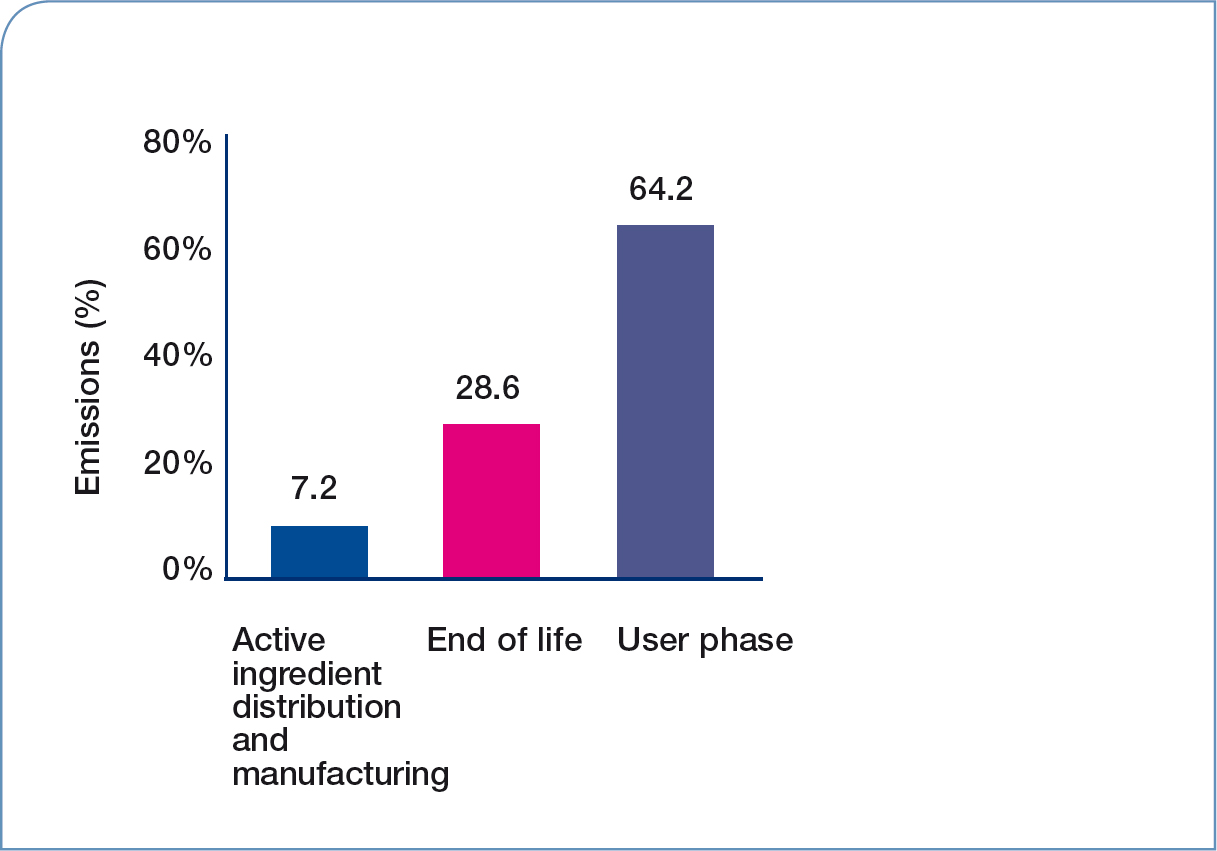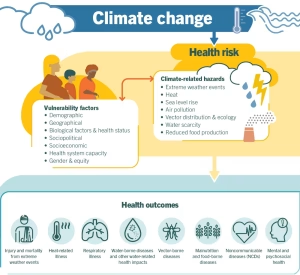Climate pollution from inhalers has the impact of half a million cars per year, study finds – CNN

Report on the Environmental Impact of Medical Inhalers and Alignment with Sustainable Development Goals
Introduction: The Intersection of Public Health (SDG 3) and Climate Action (SDG 13)
Recent research highlights a critical conflict between public health interventions and environmental sustainability, directly impacting Sustainable Development Goal 3 (Good Health and Well-being) and SDG 13 (Climate Action). An estimated 34 million Americans with chronic lung diseases, including 28 million with asthma, rely on metered-dose inhalers (MDIs). However, these devices utilize hydrofluoroalkanes (HFAs) as propellants, which are potent greenhouse gases. This creates a detrimental feedback loop where the treatment for respiratory conditions, often exacerbated by climate change, contributes significantly to the warming of the planet.
- The propellants (HFAs) used in MDIs have a global warming potential thousands of times more powerful than carbon dioxide.
- This direct contribution to climate change undermines global efforts under SDG 13.
- The worsening air quality resulting from climate change increases the prevalence and severity of respiratory illnesses, placing further strain on achieving the targets of SDG 3.
Quantifying the Climate Impact
Studies published in the journal JAMA quantify the substantial contribution of MDIs to greenhouse gas emissions. The findings reveal a significant environmental footprint that challenges the sustainability of current medical practices.
- In a single year, pollution from HFA inhalers in the United States was equivalent to the annual emissions of over 500,000 gasoline-powered cars.
- Between 2014 and 2024, 1.6 billion inhalers dispensed in the U.S. generated 24.9 million metric tons of carbon dioxide equivalent (CO2e).
- Over that decade, annual emissions from inhalers increased by 24%, from 1.9 million to 2.3 million metric tons of CO2e.
- Metered-dose inhalers were found to be responsible for 98% of all climate pollution from inhaler products.
Promoting Responsible Consumption and Production (SDG 12) in Healthcare
The challenge posed by HFA inhalers presents a clear opportunity to advance SDG 12 (Responsible Consumption and Production) within the healthcare sector. Viable, lower-emission alternatives, such as dry-powder inhalers (DPIs), exist and have demonstrated significant potential for decarbonization without compromising patient care.
- Alternative Technologies: Dry-powder inhalers do not use HFA propellants and thus have a negligible climate impact compared to MDIs.
- Proven Success: A concerted effort by the U.S. Veterans Administration to prioritize DPIs over MDIs led to a 68% reduction in associated greenhouse gas emissions between 2008 and 2023.
- International Commitments: The Kigali Amendment, ratified by the U.S., commits the nation to an 85% reduction in hydrofluorocarbons by 2036. This policy directly supports the phase-down of HFA-based inhalers and encourages a transition to more sustainable alternatives.
Addressing Barriers and Ensuring Equity (SDG 10)
While transitioning to environmentally friendly inhalers is a critical step, it must be managed carefully to avoid exacerbating inequalities, a key concern of SDG 10 (Reduced Inequalities). Several barriers currently hinder a universal switch to DPIs.
- Clinical Limitations: Certain patient populations, including young children and some frail elderly individuals, may be unable to generate the strong, quick breath required to use DPIs effectively.
- Economic Disparities: Many HFA-based MDIs are available as inexpensive generics, whereas DPIs are often newer, branded, and more costly. A lack of comprehensive insurance coverage for these alternatives can create a significant financial barrier for patients.
- Market Availability: The United States currently has fewer DPI options available compared to markets in Europe, limiting choice for both clinicians and patients.
Conclusion: A Path Forward for Sustainable Respiratory Care
The environmental impact of metered-dose inhalers represents a significant and actionable opportunity for the healthcare sector to contribute to global climate goals. While inhaler emissions are a small part of the total global carbon footprint, their reduction is a “low-hanging fruit” in healthcare decarbonization. A successful transition requires a multi-pronged strategy that balances environmental responsibility with patient needs. This includes policy incentives to reduce the cost of alternatives, expanded insurance coverage, and continued innovation to develop new, low-emission devices suitable for all patient populations. By addressing this issue, the healthcare community can advance SDG 3, SDG 10, SDG 12, and SDG 13 simultaneously, ensuring a healthier future for both people and the planet.
Analysis of Sustainable Development Goals in the Article
1. Which SDGs are addressed or connected to the issues highlighted in the article?
The article highlights issues that are directly connected to several Sustainable Development Goals (SDGs). The analysis identifies the following SDGs as relevant:
-
SDG 3: Good Health and Well-being
This goal is central to the article, which focuses on the health of individuals with chronic lung diseases like asthma and chronic obstructive pulmonary disease (COPD). It discusses the treatment for these conditions using metered-dose inhalers and the health risks associated with climate change-induced air pollution. The article states, “About 34 million Americans have a chronic lung disease,” directly addressing the prevalence of non-communicable diseases and the need for effective treatment to ensure healthy lives.
-
SDG 12: Responsible Consumption and Production
The article examines the environmental impact of a specific consumer product: metered-dose inhalers. It highlights the unsustainable nature of these products due to the use of hydrofluoroalkanes (HFAs) as propellants, which are powerful greenhouse gases. The discussion around switching to “an alternative inhaler that emits fewer problematic propellants,” such as dry-powder inhalers, directly relates to promoting sustainable production and consumption patterns within the healthcare sector.
-
SDG 13: Climate Action
This goal is a primary theme of the article. The text explicitly links the use of HFA inhalers to climate change, describing them as “substantial contributors to planet-warming pollution.” It quantifies their impact, stating that HFAs “have a global warming potential thousands of times more powerful than carbon dioxide.” Furthermore, it discusses policy actions and international agreements like the Kigali Amendment, which aim to mitigate these emissions, directly aligning with the core objectives of SDG 13.
2. What specific targets under those SDGs can be identified based on the article’s content?
Based on the article’s content, several specific SDG targets can be identified:
-
Target 3.4: Reduce by one-third premature mortality from non-communicable diseases through prevention and treatment and promote mental health and well-being.
The article’s focus on the “34 million Americans” with chronic lung diseases like asthma and the essential role of inhalers in their treatment directly relates to this target. The discussion about ensuring patients “still have access to inhalers” underscores the importance of continued treatment for non-communicable diseases to prevent complications and premature mortality.
-
Target 3.9: By 2030, substantially reduce the number of deaths and illnesses from hazardous chemicals and air, water and soil pollution and contamination.
The article connects climate change to worsening air quality, noting that “higher temperatures bring more weather phenomena that trigger breathing issues like droughts, floods and wildfires.” This directly links air pollution—a key component of this target—to an increase in illnesses for vulnerable populations with respiratory conditions.
-
Target 12.4: By 2020, achieve the environmentally sound management of chemicals and all wastes throughout their life cycle… and significantly reduce their release to air, water and soil to minimize their adverse impacts on human health and the environment.
This target is directly addressed through the article’s focus on hydrofluoroalkanes (HFAs), the chemical propellants in inhalers. The article explains that when HFAs are “released into the air, [they] trap heat in the atmosphere.” The entire discussion about phasing down HFA inhalers in favor of alternatives like dry-powder inhalers is about reducing the release of a harmful chemical into the atmosphere to minimize its environmental impact.
-
Target 13.2: Integrate climate change measures into national policies, strategies and planning.
The article provides concrete examples of this target in action. It mentions the “Kigali amendment ratified in 2016,” under which “the US committed to reduce hydrofluorocarbons by about 85% before 2036.” It also highlights a specific institutional policy: “Since 2021, the US Veterans Administration has prioritized dry-powder inhalers over traditional versions with propellants,” which is a clear integration of climate change mitigation measures into healthcare planning.
3. Are there any indicators mentioned or implied in the article that can be used to measure progress towards the identified targets?
Yes, the article mentions or implies several quantitative and qualitative indicators that can be used to measure progress:
-
Indicators for SDG 3 (Good Health and Well-being)
- Prevalence of non-communicable diseases: The article provides a baseline number: “About 34 million Americans have a chronic lung disease, including 28 million who have asthma.” This figure can be tracked over time to measure the burden of these diseases (related to Target 3.4).
- Incidence of illness due to air pollution: The article implies an indicator by stating that the number of people with asthma “is expected to grow as higher temperatures bring more weather phenomena that trigger breathing issues.” Tracking the incidence of respiratory attacks or new diagnoses linked to air quality events would be a measure for Target 3.9.
-
Indicators for SDG 12 (Responsible Consumption and Production)
- Amount of hazardous chemicals released: The article quantifies the emissions from inhalers, stating they generated “24.9 million metric tons of annual carbon dioxide equivalent emissions (CO2e)” between 2014 and 2024. It also notes that “Annual emissions increased 24% from 1.9 million to 2.3 million metric tons of CO2e over that decade.” These figures serve as direct indicators for measuring the release of HFAs (Target 12.4).
-
Indicators for SDG 13 (Climate Action)
- Progress in implementing national policies: The commitment “to reduce hydrofluorocarbons by about 85% before 2036” under the Kigali Amendment is a specific, measurable policy goal (Indicator for Target 13.2).
- Reduction in greenhouse gas emissions from specific sectors: The article provides a clear indicator of a policy’s success: the US Veterans Administration’s shift to dry-powder inhalers “reduced planet-warming gases by more than 68% from 2008 to 2023.” This percentage reduction is a direct measure of climate action effectiveness (Indicator for Target 13.2).
4. Table of SDGs, Targets, and Indicators
| SDGs | Targets | Indicators Identified in the Article |
|---|---|---|
| SDG 3: Good Health and Well-being | 3.4: Reduce premature mortality from non-communicable diseases.
3.9: Reduce illnesses from air pollution. |
|
| SDG 12: Responsible Consumption and Production | 12.4: Achieve environmentally sound management of chemicals (HFAs) and reduce their release to air. |
|
| SDG 13: Climate Action | 13.2: Integrate climate change measures into national policies and planning. |
|
Source: cnn.com

What is Your Reaction?
 Like
0
Like
0
 Dislike
0
Dislike
0
 Love
0
Love
0
 Funny
0
Funny
0
 Angry
0
Angry
0
 Sad
0
Sad
0
 Wow
0
Wow
0



















































.jpg.webp?itok=0ZsAnae9#)
























